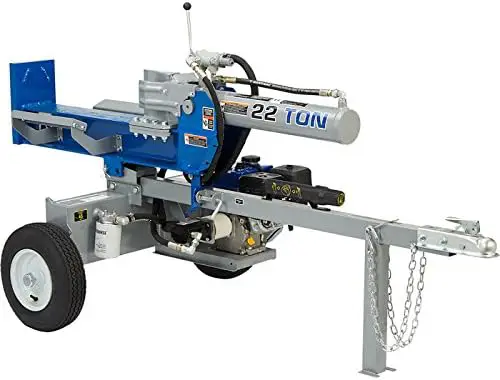Are you tired of wrestling with stubborn logs, struggling to split them into manageable pieces for your fireplace or wood stove? Say goodbye to the days of backbreaking labor and hello to efficiency with the 22 Ton Log Splitter. This powerful machine is not just another tool in your shed – it’s a game-changer for anyone who relies on firewood for warmth or business.
In this guide, my 22-ton log splitter review for 2025 is crafted to provide insightful, field-tested opinions regarding the ideal 22-ton log splitter and its worthiness as an investment.
Powerhorse Horizontal/Vertical 22 Tons Log Splitter

- Heavy-duty hydraulic system .
- 10 Micron Zinga-made Powerhorse filter.
- 100 Mesh suction strainer as a pre-filter.
- 40 Micron breather to prevent airborne contamination.
- Opposite side inlet and outlet locations for improved cooling.
About Powerhorse 22 Tons Log Splitter
The Powerhorse 22 Tons Log Splitter is a robust and efficient tool designed to tackle heavy-duty log-splitting tasks easily. Featuring a heavy-duty hydraulic system, it ensures the protection and longevity of its components by effectively preventing contaminants from entering and circulating within the system.
Equipped with a 10-Micron Zinga-made Powerhorse filter, this splitter effectively removes contaminants generated during operation or introduced during oil changes, thus maintaining optimal performance.
Its 100 Mesh suction strainer acts as a pre-filter, extending the lifespan of critical components such as the return line filter, valve, pump, and cylinder. It also prevents contaminants from passing through upstream components.
With a 40-micron breather, airborne pollutants are effectively blocked from entering the hydraulic system, further safeguarding its integrity. Moreover, its strategically positioned inlet and outlet locations on opposite sides of the tank facilitate efficient cooling of the hydraulic fluid by increasing travel time.
Key Features:
-
Heavy-duty hydraulic system
-
10 Micron Zinga-made Powerhorse filter
-
100 Mesh suction strainer
-
40-micron breather
-
Strategically positioned inlet and outlet locations
What I Like About the Powerhorse 22 Ton Log Splitter.
When it comes to splitting logs, there’s nothing quite like the Powerhorse 22 Ton Log Splitter. Let me tell you why I love it so much.
First and foremost, its heavy-duty hydraulic system is an absolute game-changer. Not only does it efficiently split logs, but it also goes the extra mile to protect and extend the life of its hydraulic components. How? Well, thanks to its innovative design, it prevents contaminants from wreaking havoc within the system.
With a built-in mechanism that stops impurities from entering and circulating through, I can trust that this log splitter will stand the test of time.
One of my standout features is the 10 Micron Zinga-made Powerhorse filter. This filter does wonders in removing pesky contaminants that might arise during operation or when adding or changing oil.
It’s like having a guardian angel watching over the hydraulic system, ensuring it stays clean and efficient throughout its lifespan.
And let’s not forget about the 100 Mesh suction strainer. This little hero acts as a pre-filter, not only prolonging the life of the return line filter but also safeguarding vital components such as valves, pumps, and cylinders from potential harm. With this level of protection, I can tackle even the toughest logs with peace of mind.
Airborne contaminants? Not a chance with the 22-Ton Log Splitter. Thanks to its 40-micron breather, I can rest easily knowing that the hydraulic system remains protected from unwanted intruders. It’s all about maintaining a clean and healthy environment for optimal performance.
And let’s not forget the smart design choice of having the inlet and outlet locations on opposite sides of the tank. This promotes efficient cooling of the hydraulic fluid, ensuring it stays at the perfect temperature for optimal performance. It’s these thoughtful touches that truly set the Powerhorse log splitter apart from the rest.
In conclusion, what I like about the Powerhorse 22 Ton Log Splitter is its power and its commitment to longevity and efficiency. With its robust hydraulic system and innovative features, splitting logs has never been easier or more reliable. It’s simply a cut above the rest.
Powerhorse Horizontal/Vertical 22 Tons Log Splitter

- Heavy-duty hydraulic system .
- 10 Micron Zinga-made Powerhorse filter.
- 100 Mesh suction strainer as a pre-filter.
- 40 Micron breather to prevent airborne contamination.
- Opposite side inlet and outlet locations for improved cooling.
What Don’t I Like?
One thing that bothers me is the weight of the machine. At 22 tons, it’s undoubtedly heavy-duty, but this also means it’s pretty bulky and challenging to move around. Transporting it from one location to another can be a hassle, primarily if you work in a remote area or need to maneuver through tight spaces.
Additionally, while the hydraulic system does an excellent job protecting its components, I’ve noticed that it requires regular maintenance to keep it operating at peak performance. This means periodically checking and replacing filters, which can be time-consuming and add to the overall cost of ownership.
Overall, while these drawbacks are relatively minor compared to the overall performance of the Powerhorse 22 Ton Log Splitter, they’re worth considering if you’re in the market for a new log splitter.
Related Post: Hydraulic Skid Steer Firewood Processors
What to Look for In a 22 Ton Log Splitter.
When considering a 22-ton log splitter, there are several key factors to look for to ensure you choose the right one for your needs:
-
Power Source: Determine whether you want a gas-powered, electric-powered, or hydraulic log splitter. Gas-powered splitters offer mobility but require fuel and maintenance. Electric splitters are quieter and easier to maintain but require access to electricity. Hydraulic splitters are robust and suitable for heavy-duty use.
-
Splitting Force: A 22-ton log splitter should provide sufficient force to effectively split most types of wood. Ensure the splitter’s splitting force meets your requirements for the size and hardness of the logs you’ll be splitting.
-
Cycle Time: Consider the cycle time of the splitter, which is the time it takes for the ram to split a log and return to its starting position. Shorter cycle times increase efficiency, allowing you to split more logs in less time.
-
Log Capacity: Check the maximum log length and diameter the splitter can accommodate. Ensure it can handle the size of logs you typically work with.
-
Durability: Look for a log splitter constructed from high-quality materials such as steel, with sturdy components and a reliable hydraulic system. A durable splitter will withstand heavy use and last for years.
-
Portability: If you need to move the splitter to different locations, consider its portability. Look for features like built-in handles, wheels, or a tow hitch for easy transportation.
-
Safety Features: Safety is paramount when using a log splitter. Look for features such as two-handed operation, automatic ram return, and guards to protect your hands and prevent accidents.
-
Brand Reputation and Warranty: Choose a log splitter from a reputable manufacturer known for producing quality equipment. Check customer reviews and warranties to ensure satisfaction and peace of mind with your purchase.
Why You Need Log Splitter.
As a homeowner, having a log splitter is crucial for several reasons. Firstly, it saves an immense amount of time and effort compared to traditional methods like chopping wood by hand with an axe. I can effortlessly split logs into firewood with minimal physical strain with a log splitter.
Using a log splitter enhances safety. Hand-splitting wood can be dangerous, especially for someone inexperienced or tired. A log splitter significantly reduces the risk of accidents, such as cuts or strains, since it requires less manual force and has built-in safety features.
A log splitter increases efficiency and productivity. Whether preparing firewood for the winter or clearing trees from my property, having a log splitter speeds up the process significantly. It allows me to tackle larger logs and a higher volume of wood in less time.
Furthermore, a log splitter provides consistency in the size and shape of the split wood. This uniformity is essential for efficient burning and stacking, ensuring the firewood fits neatly into the fireplace or wood stove.
Affiliate Disclosure: Fireplaceadviser.com is a participant in the Amazon Services LLC Associates Program. We may earn a commission when you click on certain links on this site and purchase.

Hello!! I am Jamal Khan. I often fix my home electric heaters and gas stove problems and research the common issues in the heating units to improve my knowledge and expertise. The aim of establishing fireplaceadviser.com is to share my expertise and knowledge with my audience.












